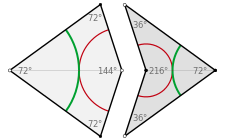RULES FOR CREATING PENROSE TILINGS
When creating a Penrose tiling, there are rules to keep in mind when arranging the tiles into their patterns. The exact specifications of these rules vary based on the type of tiles (discussed in the previous section), but ultimately, the tiles form an aperiodic pattern. How the tiles are arranged may also allow them to have reflectional or five-fold rotational symmetry.
KITE AND DART MATCHING
Recall the kite and dart, which are pieces of a rhombus that has angles of 72 and 108 degrees. There are different matching rules that ensure the tiles are put together in a form that does not have translational symmetry and thus ensures aperiodicity. For the kite and dart, there are two ways to join them.
The first method is the vertex method. As previously described, the vertices along the kite’s axis of symmetry are labelled with one color. Then, the other two opposing vertices of the kite are labelled the other color. For the other shape, which is the dart, this is reversed. When joining the tiles together, only vertices of the same color may touch.
The other way of joining the kite and dart together is to draw two different colored arcs inside both shapes. Any two shapes that are joined together must create a smooth continuation of the arcs inside them, rather than any disjointed or broken lines.
Using either of these two methods yields seven ways to fit the kite and dart around a point. The star shaped one and the sun enable five-fold rotational symmetry around the center. Patterns created using the five other starting tilings might have local five-fold symmetry at certain points in the pattern, but not throughout the whole tiling. Additionally, for all seven of these starting patterns, any local region found within the tiling will occur infinitely many times in the whole Penrose tiling. The seven originating arrangements can be seen in the figure below.


